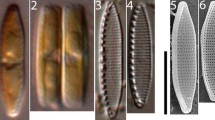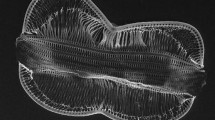Abstract
The relative nutritional status, with respect to phosphorus (P i ) vs. nitrogen (N) limitation, and light-limited photosynthesis (P s ) was examined over a broad range of quantum fluxes (I) for four Halimeda species, Halimeda tuna (Ellis and Solander) Lamouroux, H. simulans Howe, H. lacrimosa Howe and H. copiosa Goreau and Graham, taken from clear, shallow, Bahamian waters. The results support the hypothesis that psammophytic forms (i.e., sand dwellers anchored by a bulbous rhizoidal system) differ in nutrient status from epilithic forms (i.e., attached to rock by inconspicuous rhizoids). Maximum photosynthetic rates (P max) for the epilithic species H. lacrimos and H. copiosa decreased (P<0.05) following P i enrichment, but increased (P<0.05) following N pulses. Conversely, following brief exposures to P i , P max in the sand-dwelling forms H. tuna and H. simulans was elevated (P<0.05). These findings suggest that shallow species of Halimeda are adapted to take advantage of episodic nutrient pulses, and that partitioning of limiting resources may occur between the various life forms. Shallow water Halimeda species appear well adapted to variable light regimes, including low light conditions. In all cases, light-saturated photosyntheses (I k ) occurred at irradiances much lower than the ambient levels available on typical sunny days. Associated with low saturation irradiances were low light requirements for photosynthetic compensation (I c ) and reasonably efficient use of low photon flux densities as indicated by relatively steep slopes (α) of the P s vs. I curves. Of the four species, H. copiosa was the most shade adapted, with considerably higher α values and considerably lower I c , I k and photoinhibition values.
Similar content being viewed by others
References
Adey WH, Adey PJ, Burke R, Kaufman L (1977) The Holocene reef systems of eastern Martinique, French West Indies. Atoll Res Bull 218:1–40
Arnold KE, Murray SN (1980) Relationships between irradiance and photosynthesis for marine benthic green algae (Chlorophyta) of differing morphologies. J Exp Mar Biol Ecol 43:183–192
Berner RA (1974) Kinetic models for the early diagenesis of nitrogen, phosphorus, and silicon in anoxic marine sediments. In: Goldberg ED (ed) The sea, vol 5. Wiley, New York, pp 427–450
Borowitzka MA, Larkum AWD (1976) Calcification in the green alga Halimeda. II. The exchange of Ca2+ and the occurrence of age gradients in calcification and photosynthesis. J Exp Bot 27:864–878
Broecker WS, Peng TH (1982) Tracers in the sea. Eldigio Press, New York
Buesa RJ (1977) Photosynthesis and respiration of some tropical marine plants. Aquat Bot 3:203–216
Chapman ARO, Craigie JS (1977) Seasonal growth in Laminaria longicruris: relations with dissolved inorganic nutrients and internal reserves of nitrogen. Mar Biol 40:197–205
Chapman F, Mawson D (1906) On the importance of Halimeda as a reefforming organism: with a description of the Halimeda-limestones of the New Hebrides. J Geol Soc Lond 62:702–711
Davies PJ, Marshall JF (1985) Halimeda bioherms — low energy reefs, northern Great Barrier Reef. Proc 5th Int Coral Reef Symp 5:1–7
Ginsburg RN (1956) Environmental relationships of grain size and constituent particles in some south Florida carbonate sediments. Bull Am Assoc Petrol Geol 40:2384–2427
Hanisak MD (1979) Growth patterns of Codium fragile spp. tomentosoides in response to temperature, irradiance, salinity, and nitrogen source. Mar Biol 50:319–332
Hillis-Colinvaux L (1977) Halimeda and Tydemania: distribution, diversity and productivity at Enewetak. Proc 3rd Int Coral Reef Symp 1:365–370
Hillis-Colinvaux L (1980) Ecology and taxonomy of Halimeda: primary producer of coral reefs. Adv Mar Biol 17:1–327
Hillis-Colinvaux L (1986) Halimeda growth and diversity on the deep fore-reef of Enewetak Atoll. Coral Reefs 5:19–21
Hudson JH (1985) Growth rate and carbonate production in Halimeda opuntia: Marquesas Keys, Florida. In: Toomey DF, Nitecki MH (eds) Paleoalgology: contemporary research and applications. Springer, Berlin Heidelberg New York, pp 257–263
Jensen PR, Gibson RA, Littler MM, Littler DS (1985) Photosynthesis and calcification in four deep-water Halimeda species (Chlorophyceae, Caulerpales). Deep-Sea Res 32:451–464
Lapointe BE (1985) Strategies for pulsed nutrient supply to Gracilaria cultures in the Florida Keys: interactions between concentration and frequency of nutrient pulses. J Exp Mar Biol Ecol 93:211–222
Lapointe BE (1986) Phosphorus-limited photosynthesis and growth of Sargassum natans and Sargassum fluitans (Phaeophyceae) in the western North Atlantic. Deep-Sea Res 33:391–399
Lapointe BE (1987) Phosphorus- and nitrogen-limited photosynthesis and growth of Gracilaria tikvahiae (Rhodophyceae) in the Florida Keys: an experimental field study. Mar Biol 93:561–568
Lapointe BE, Littler MM, Littler DS (1987) A comparison of nutrient-limited productivity in macroalgae from a Caribbean barrier reef and from a mangrove ecosystem. Aquat Bot 28:243–255
Lapointe BE, Tenore KR, Dawes CJ (1984) Interactions between light and temperature of the physiological ecology of Gracilaria tikvahiae (Gigartinales: Rhodophyta). I. Gross photosynthesis and respiration. Mar Biol 80:161–170
Littler MM (1979) The effects of bottle volume, thallus weight, oxygen saturation levels, and water movement on apparent photosynthetic rates in marine algae. Aquat Bot 7:21–34
Littler MM, Littler DS, Taylor PR (1983) Evolutionary strategies in a tropical barrier reef system: functional-form groups of marine macroalgae. J Phycol 19:229–237
Littler MM, Littler DS, Blair SM, Norris JN (1985) Deepest known plant life discovered on an uncharted seamount. Science 227:57–59
Littler MM, Littler DS, Blair SM, Norris JN (1986a) Deep-water plant communities from an uncharted seamount off San Salvador Island, Bahamas: distribution, abundance, and primary productivity. Deep-Sea Res 33:881–892
Littler MM, Littler DS, Lapointe BE (1986b) Baseline studies of herbivory and eutrophication on dominant reef communities of Looe Key National Marine Sanctuary. NOAA Technical Memorandum, NOS MEMD 1, Washington, DC
Mazzella L, Alberte RS (1986) Light adaptation and the role of autotrophic epiphytes in primary production of the temperate seagrass, Zostera marina L. J Exp Mar Biol Ecol 100:165–180
McRoy CP, Lloyd DS (1981) Comparative function and stability of macrophyte-based ecosystems. In: Longhurst AR (ed) Analysis of marine ecosystems. Academic Press, New York, pp 473–489
Meyer JL, Schultz ET, Helfman GS (1983) Fish schools: an asset to corals. Science 220:1047–1049
Milliman JD (1974) Recent sedimentary carbonates. Marine carbonates, part I. Springer, Berlin Heidelbert New York
Myers VB, Iverson RI (1981) Phosphorus and nitrogen limited phytoplankton productivity in northeastern Gulf of Mexico coastal estuaries. In: Estuaries and nutrients. Humana, Clifton, NJ, pp 569–582
Parsons TR, Takahashi M, Hargrave B (1977) Biological oceanographic processes. Pergamon Press, New York
Ramus J (1981) The capture and transduction of light energy. In: Lobban CS, Wynne MJ (eds) The biology of seaweeds. University of California Press, Berkeley, pp 458–492
Redfield AC (1958) The biological control of chemical factors in the environment. Am Sci 46:205–221
Rosenfeld JK (1979) Interstitial water and sediment chemistry of two cores from Florida Bay. J Sed Petrol 49:989–994
Ryther JH, Dustan WM (1971) Nitrogen, phosphorus, and eutrophication in the coastal marine environment. Science 171:1008–1013
Smith SV (1984) Phosphorus versus nitrogen limitation in the marine environment. Limnol Oceanogr 29:1149–1160
Smith VH (1983) Light and nutrient dependence of photosynthesis by algae. J Phycol 19:306–313
Syrett PJ (1953) The assimilation of ammonia by nitrogen-starved cells of Chlorella vulgaris. I. A correlation of assimilation with respiration. Ann Bot London 17:1–19
Topinka JA, Robbins JV (1976) Effects of nitrate and ammonium enrichment on growth and nitrogen physiology in Fucus spiralis. Limnol Oceanogr 21:659–664
Vince S, Valiela I (1973) The effects of ammonium and phosphate enrichments on chlorophyll a, pigment ratio and species composition of phytoplankton of Vineyard Sound. Mar Biol 19:69–73
Zimmerman RC, Kremer JN (1984) Episodic nutrient supply to a kelp forest ecosystem in Southern California. J Mar Res 42:591–604
Author information
Authors and Affiliations
Rights and permissions
About this article
Cite this article
Littler, M.M., Littler, D.S. & Lapointe, B.E. A comparison of nutrient- and light-limited photosynthesis in psammophytic versus epilithic forms of Halimeda (Caulerpales, Halimedaceae) from the Bahamas. Coral Reefs 6, 219–225 (1988). https://doi.org/10.1007/BF00302018
Accepted:
Issue Date:
DOI: https://doi.org/10.1007/BF00302018




